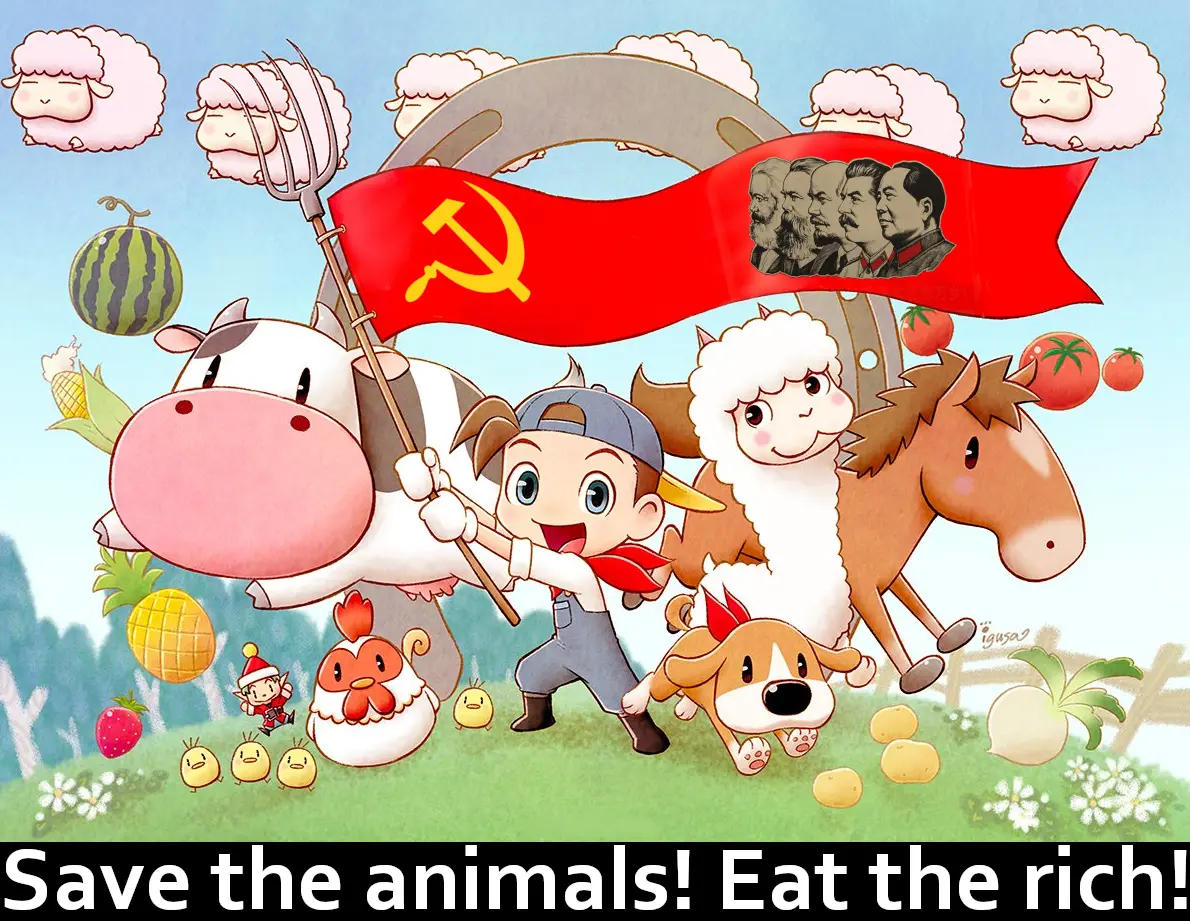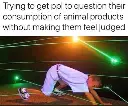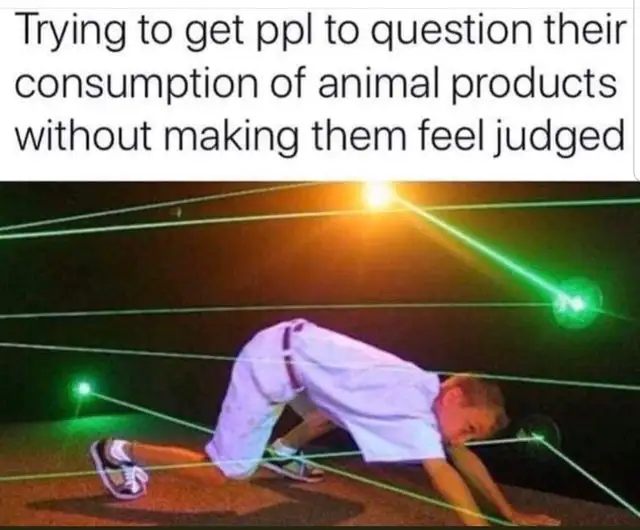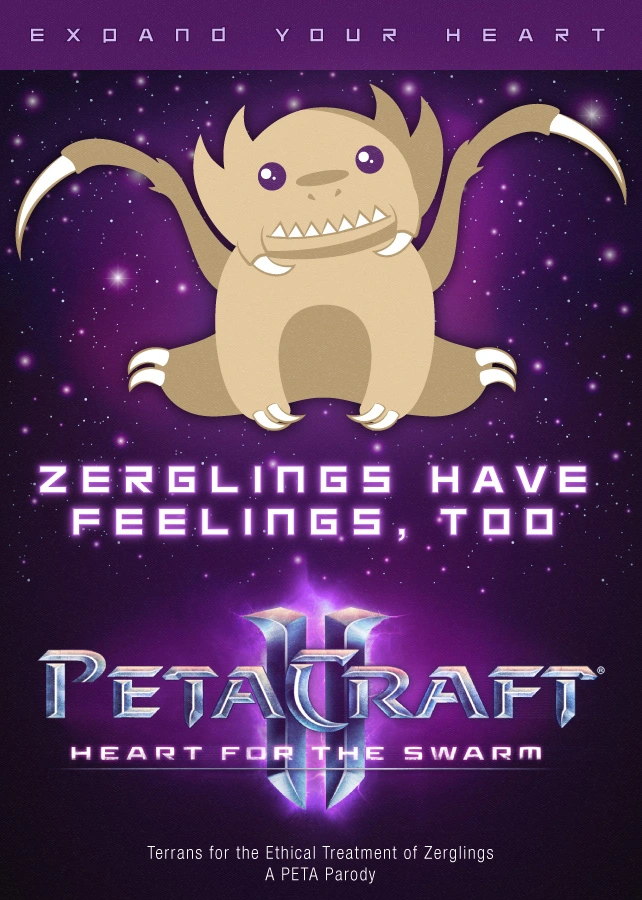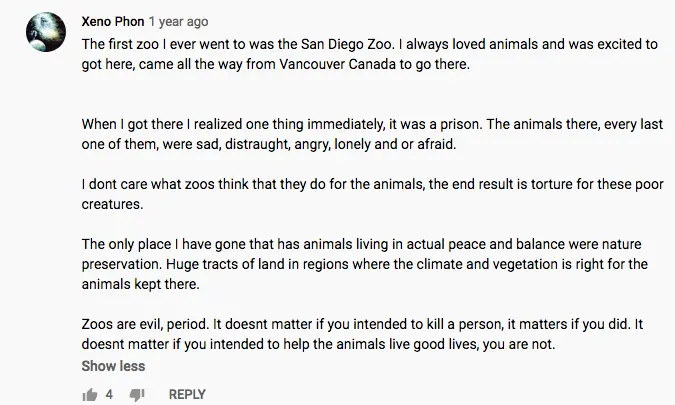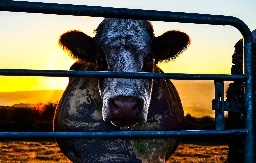Revolutionary Veganism
- observatory.wiki Our Food System Is the Bullseye for Solving the World’s Climate Challenges
The industrialized food system is a major source of greenhouse gas emissions, but it is not a major topic at climate talks.
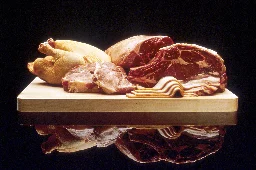
I found this article on mronline.org. It claims that moving away from animal rearing for meat harvest will be instrumental in combating climate change. Some interesting excerpts:
> A systems engineering analysis of climate science and animal agriculture published in the Journal of Ecological Society in 2019 by Sailesh Rao, the founder and executive director of Climate Healers, an environmental nonprofit, backs up the claim that the majority of analyses of agricultural emissions are low. Rao’s paper found that “animal agriculture is the leading cause of climate change, responsible for at least 87 percent of greenhouse gas emissions annually.”
> In a research study led by the University of Oxford and published in the journal Nature Food in July 2023, it was found that adopting a vegan diet resulted in significant reductions in climate-heating emissions, water pollution, and land usage, reaching an impressive 75 percent decrease compared to diets containing over 100 grams of meat per day. Furthermore, the study highlighted that vegan diets also played a crucial role in reducing the destruction of wildlife by 66 percent and cutting water consumption by 54 percent.
> Beef is so resource-intensive to produce, that it requires 20 times more land and emits 20 times more greenhouse gases per gram of edible protein than beans, lentils, and peas—all commonly farmed plant proteins, according to the World Resources Institute.
> “Concurrently replacing all animal-based items in the U.S. diet with plant-based alternatives will add enough food to feed, in full, 350 million additional people, well above the expected benefits of eliminating all supply chain food waste,” according to a 2018 study by an international team of researchers published in the journal Proceedings of National Academy of Sciences of the United States of America. The authors note that the results of their study “highlight the importance of dietary shifts to improving food availability and security.”
Of course most people who have looked into this topic know about this stuff already. But the numbers themselves are staggering. For example, moving U.S. diet to being plant based feeding 350 million additional people. I had not considered that angle before.
-
Dangerous Pathogens and Cruelty Law Violations at Perdue Subsidiary, Animal Rights Report Alleges (DxE Open Rescue)
theintercept.com Dangerous Pathogens and Cruelty Law Violations at Perdue Subsidiary, Animal Rights Report AllegesDangerous pathogens and violations of animal cruelty laws were found at Perdue Farms subsidiary Petaluma Poultry, alleges a Direct Action Everywhere report.
Hours before dawn on Tuesday, eight animal liberation activists entered the Petaluma Poultry slaughterhouse facility in Sonoma County, California, disguised as workers, with the aim of rescuing as many chickens as possible.
Meanwhile, approximately 175 protesters gathered outside the property, where up to 49,000 chickens are killed every day, and where animal rights activists allege animal abuses and risks to public health are rampant. Some of the demonstrators joined those who had entered the property to assist in the planned “open rescue” action: a tactic by which activists publicly remove ailing animals from factory farms and bring them to animal sanctuaries, while highlighting the harms of the meat and animal products industry.
By 3 a.m. PT, as partly captured in a video shared exclusively with The Intercept, activists had removed 11 chickens from trucks that had transported thousands of chickens onto the slaughterhouse property, packed together as tightly as physically possible. Seven more birds were rescued soon after from a truck on its way to the facility.
I’m in Tuesday’s rescue and demonstration, organized by activists affiliated with animal rights group Direct Action Everywhere, or DxE, coincided with the release of a report from the group Tuesday morning. Shared with The Intercept and disseminated to regulatory agencies, the report alleges that Petaluma Poultry, a subsidiary of agribusiness giant Perdue Farms, is routinely violating animal cruelty laws and exposing the public to major health risks — including the possibility of future zoonotic disease pandemics — through brutal and negligent treatment of birds marketed as “free range” and “organic.”
The new report is based on undercover investigations at the slaughterhouse and a half dozen of Petaluma’s supplier farms, including whistleblower reports, firsthand observations, and hidden camera footage, alongside findings from veterinary medicine experts and infectious disease specialists who carried out fecal tests and examined animals — some sick, some already dead — brought to them from Petaluma facilities by DxE activists. (Petaluma Poultry and Perdue Farms did not immediately respond to The Intercept’s requests for comment on Tuesday morning’s report release and rescue.)
The very same animals that are cheerily packaged and sold in grocery stores nationwide under the personalizing brand names “Rocky” and “Rosie” — “Rosie” was the first chicken line in the United States to carry a certified organic label — are processed in a slaughterhouse where undercover investigator Raven Deerbrook said she found animals that were tortured and sick and where workers labored in dangerous conditions.
A dead chicken lies on a dirt covered shelf in 2023.
Photo: Courtesy of Direct Action Everywhere (DxE)
Deerbrook’s account and materials formed the basis of parts of the new DxE report, which the group sent to local, state, and federal authorities to request official investigations. DxE sent its report to USDA Farm Service Agency California Executive Director Blong Xiong; California Gov. Gavin Newsom and Attorney General Rob Bonta; Sonoma County Animal Services, District Attorney Carla Rodriguez, Sheriff Eddie Engram, and Administrator Christina Rivera; and a host of other officials and agencies from nearby counties.
“Hundreds are discovered to be so diseased that they are condemned after being slaughtered.”
“I am seeing sick birds being crowded onto trucks by the thousands. Dozens are dying on the way to the slaughterhouse,” Deerbrook, who entered the slaughterhouse undetected in a worker’s uniform, photographed internal documents, and set up hidden cameras, alleged over Signal message. “Hundreds are discovered to be so diseased that they are condemned after being slaughtered.”
Deerbrook, who worked for months gathering materials for the DxE report, said that she saw chickens injured while being hung on the slaughter line; she photographed company reports about bruised birds, which is a sign of abuse; she saw evidence of birds missing the “stun bath”: an electrical water bath in which birds’ heads are dipped to stun them unconscious before slaughter. She added that she saw “birds trying to escape and being cut-into while they were conscious, and I see evidence of them being boiled alive.” She also charged that she saw workers performing “one of the most dangerous tasks (live hanging) in pitch darkness, and many are suffering with pain and injuries.”
None of the local, state, and federal officials and agencies that received the report responded immediately to The Intercept’s request for comment.
Over 1,000 animals were “condemned” — disqualified from the food supply — on a single day in April 2023 after being slaughtered, according to documents from the slaughterhouse obtained by Deerbrook over a three-month period. Hundreds of them were condemned due to septicaemia, a form of bacterial blood poisoning, and toxemia. The investigation included lab reports from veterinarians that found dangerous pathogens in several birds. The slaughterhouse was also found to have unusually high rates of salmonella and campylobacter, two bacteria that cause widespread illnesses in humans, according to a local press report citing government data.
While Covid-19 was not transmitted to humans through factory farming, the deadliest pandemic in U.S. history should have prompted a reckoning over how we think about zoonotic disease spread and the undeniable future pandemic risks of intensive animal produce industry. Like so many ostensible pandemic reckonings, the dangerously concentrated — not to mention torturous — mass production of meat and animal products continues unfettered. Related Amid Bird Flu Outbreak, Meat Producers Seek “Ventilation Shutdown” for Mass Chicken Killing
“Direct Action Everywhere (DxE) investigators made repeated visits to six Petaluma Poultry-supplying factory farms in Northern California,” the report says. “They documented routine violations of California’s animal cruelty laws, including birds collapsed on the floor or stuck on their backs and unable to walk to food or water, left to slowly starve to death, as well as infectious diseases that threaten public health. Yet, despite dozens of reports to county and state authorities, the government still refuses to hold the company accountable.”
Current felony defendant Rachel Ziegler holds a bird removed from a barn at McCoy’s Poultry on Sept. 29, 2018.
Photo: Courtesy of Direct Action Everywhere (DxE)
DxE has been making allegations about cruelty and neglect at Petaluma Poultry since at least 2018, when, following investigations into widespread animal cruelty at its facilities, the animal rights group’s activists carried out a previous mass rescue action at Petaluma supplier, McCoy’s Poultry. After examining birds retrieved from the farm, Sonoma County’s own Animal Services Department referred McCoy’s to the sheriff’s office as a suspect in an animal cruelty case. The facility was shuttered, but no such charges materialized.
Meanwhile, 58 activists were arrested on felony charges for their involvement in the attempted rescue that drew attention to these systematic abuses. Many of these cases have since been dropped or resolved through diversions or plea deals. Four people involved in nonviolent protest actions against factory farms are currently still facing criminal charges in Sonoma County, including a total of 12 felony charges.
“The diseases and bacteria that we found are pretty shocking.”
“Following the 2018 rescue effort at McCoy’s Poultry, that facility closed down, but the cruelty we found there was not an isolated incident,” said Zoe Rosenberg, a DxE activist who participated in Tuesday’s rescue effort. “We have continued to investigate Petaluma Poultry farms across Northern California and we have repeatedly found sick, injured, collapsed, and starving animals.”
Rosenberg said that “the diseases and bacteria that we found are pretty shocking.” The pathogen Clostridium perfringens, which was found in the necropsy report carried out by the California Animal Health and Food Safety Lab at the University of California, Davis of a chicken from the farm, according to the DxE report, can cause necrotic enteritis in humans: a bowel disease that kills up to 50 percent of humans who contract it and is responsible for 8 percent neonatal intensive care unit admissions. “This industry is hurting all of us, especially those who are immunocompromised like I am,” Rosenberg, who has a chronic illness, told me.
“75% of new or emerging infectious diseases in humans come from animals,” the DxE report says. “We see the perfect breeding ground for such new diseases to emerge in the filthy, crowded, and disease-ridden conditions at Petaluma Poultry factory farms, particularly given the company’s inability to keep these diseases out of the slaughterhouse and the food supply.”
Police were called to the Petaluma Poultry slaughterhouse in response to Tuesday’s action, but all the activists on the property had left with the rescued chickens by the time cops entered the facility. None of the rescue participants on Tuesday morning have been arrested at the time of writing.
Previous rescues have led to numerous arrests and charges, but DxE has a strong record when it comes to winning cases in court. In March, two DxE activists, Alicia Santurio and Alexandra Paul, were acquitted in California of theft charges over the rescue of two chickens from Foster Farms.
-
What's your favourite meal thats easy to cook?
Share the thing you make when you're hungry, but dont have the energy to make something complicated
I think it'd be nice to have a thread for people to share food ideas, also i'd like some ideas myself
-
Hey!
Some of these communities aren't very active, so for the time being, let's merge them or at least keep an eye on related subcommies! [email protected] [email protected] <3
-
How to make great TVP
TVP is an underrated, cheap and convenient mock meat but do you ever struggle to get it to taste really good?
There are about a million different variations on how to make seasonings and broths but it always seems like TVP ends up as a soggy mass of bland, spongy textured stuff that has a strong cardboard-y aftertaste which has a tendency to permeate whatever dish it's added to.
So how do you up your TVP game?
This method from Chef Jana has a technique that I haven't seen anywhere else before and that is to fry the TVP before you add any broth.
What does this achieve?
First of all, this gives the TVP a delicious, almost al-dente texture like you would expect from ground beef.
Second, it prevents your TVP from becoming waterlogged.
Third, the broth you add and cook down into the TVP is effectively retained in the TVP so you can achieve flavoring contrasts like you would get normally with non-veg dishes.
Fourth, the strength of your broth flavoring will be roughly the same as the final strength of flavor in your TVP which makes it very easy to estimate how to season the broth and how much seasoning to use.
Fifth, by shaking off any excess TVP flour you eliminate the majority of the cardboard-y aftertaste and with a properly seasoned broth you will mask any remaining cardboard taste.
Sixth, and this is the big one, you will achieve a high level of browning and fond which will increase the contrast of flavors and it will bring a richness that TVP usually lacks.
Remember to fry your TVP in deodorized coconut oil or vegetable shortening because the high level of saturated fat will impart a very meat-like mouthfeel and remember that it will take at least a few minutes to brown up but just keep faith and keep stirring because it will suddenly begin browning up all at once and you want to distribute that across all the TVP as well as you can.
If you find that you have too much fond on the bottom of your pan or you're worried that it's getting too dark and it risks burning you can deglaze the pan with a minimal amount of very hot or boiling liquid (water, broth, wine etc.) but keep in mind that you want to be very conservative in how much you add because you don't want to braise your TVP and it should be hot liquid because you want it to evaporate from the pan ASAP. Also, if you deglaze very early in the process you may retard the browning process and you really want to avoid doing that wherever possible.
That's really all there is to it!
Stay tuned for an effortpost on how to season broths for mock meat and how to balance the flavors.
-
Comrades, what is to be done about the hog problem?
Is there even a reasonable and practical solution to the feral hog problem which is not especially cruel to the hogs?
What do you think is the best way to deal with all these hogs?
-
What the fuck is up with non-vegan leftists?
I've talked to many non-vegan leftists and they are the most puzzling type of person to me.
Like how are they even justifying participating in animal torture to themselves? All the things they critique about the brutality of capitalism could be applied them just easily! Somehow most of them seem incapable of entertaining the thought that perhaps actively and willfully engaging in the practices they themselves deem morally reprehensible is not the best course of action (gasp!) .
Every time I try to reason with them they pull same straw-grasping bullshit as liberals desperately trying to hold on to their unjustifiable beliefs -- it's the same arguments from them every time too:
- "no ethical comsumption under capitalism"
- "not everybody can be vegan"
- "unsustainable diet"
Do they seriously not see the hypocrisy or are they actually incapable of making a small sacrifice of their own happiness for the good of animals‽
-
I've found my favorite post ever
For anybody out of the loop, we're mocking anti-vegan arguments in the context of wearing a mask. As much as I laugh reading the thread, I also get angry because I've heard every single one of these arguments through my life. Enjoy, comrades!
-
vegan Bechamel?
I've tried making bechamel with soy milk and oat milk, and not a fan of either right now. I think I should try a nut milk. Any recommendations? Also I think I might want to try soy milk again because the last one I used had added sugar and also I slightly burned the roux. Any other tips for vegan bechamel?
-
Prototype Vegantifa Supersoldier

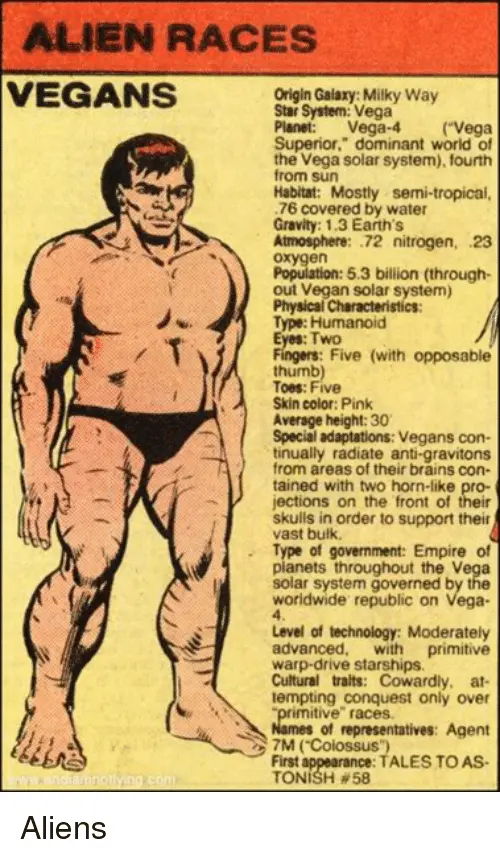
You can read the comic here: https://readcomiconline.to/Comic/Tales-to-Astonish-1959/Issue-58?id=31002#1
-
Calvin and Hobbes is vegan?

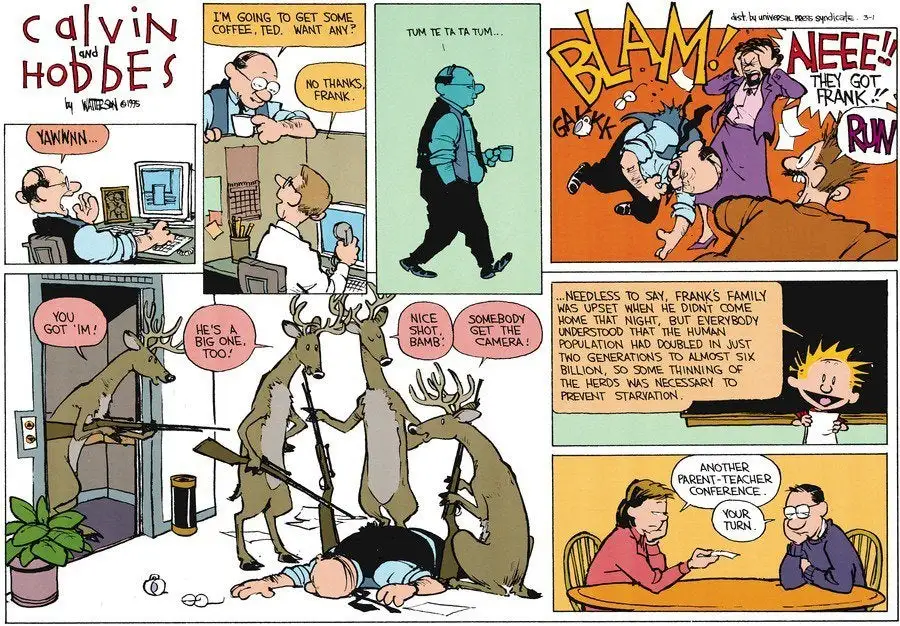
Calvin and Hobbes, Bizarro, and The Far Side are my favorite comic series. Honorable mention to The Onion's e-comics.
-
Graffiti stencil


Text: Meat = Murder
This was my first handmade stencil, my first attempt was a disaster, I used scissors and lost the integrity of the material. Here I punctured the plastic with a knife and it's much sturdier.
-
What to do with oatmeal?
I really liked oatmeal just boiled in milk with (sometimes) some peanut butter. Felt like a lean, clean meal. Oatmeal releases energy slowly so it's a good way of getting carbs without getting fat.
How do I make oatmeal as a vegan? I don't have access to stuff like almond milk where I am, so instead of substituting milk if you want to suggest different recipes altogether that would be nice. I also prefer ease over taste.
-
Authentic Cantonese Chow Mein, vegan style
This recipe is coming directly from here. You can also find a video demonstration of the recipe in that post.
Since the discussion is in-depth in that post, I'm not going to replicate all of that here but here are the substitutions:
- Replace the egg noodles with the same amount of rice vermicelli.
Do not place paper towel over them once the noodles have cooked as they will stick like hell to it. They will cook through just fine without it, believe me. I have found that Vietnamese rice vermicelli tends to have a tougher consistency than other styles, which is ideal for these sorts of dishes. I use Dongguan brand and they are ideal for fried noodle dishes like this. Try to find the the thicker, tougher looking vermicelli because the very fine vermicelli are a bit harder to work with in a wok. You could also use flat rice noodles - the consistency will be different but I doubt anyone's going to heckle you for it.
- Replace the fish sauce
Fish sauce substitutes are usually overdone in the west. Use some Golden Mountain sauce (ideally), some Maggi sauce, some liquid aminos etc. instead. If you are really craving that true fishy taste (lol why?) then you can add in some seaweed like nori strips or even boil some kelp (Kombu) for 10 minutes and use the water from that.
That's really all there is to it.
This dish is extremely simple and tasty, and it lends itself well to vegan cooking. I'd recommend subscribing to their youtube channel because they have a lot of great authentic dishes and lots of Chinese cuisine lends itself well to vegan adaptation.
-
Kenji's black bean burgers, vegan style
This recipe is adapted from here and you can watch Kenji himself making it with a headcam here if that helps you get the process clear in your mind.
The substitutes from the original recipe are the egg and the feta. You can play around with these as they aren't central to the recipe. Simple egg substitutes include chia seeds, flaxseed, and gram flour. Simply use 3 tablespoons of water and mix in 1 tablespoon of chia seeds or 1 tablespoon of ground flaxseed/flaxseed meal or 3 tablespoons of gram flour (aka chickpea flour). You could probably use about 1/2 cup of cooked chickpeas mashed or pureed, ensuring that they amount to a rounded 1/3 cup. If you're doing this, set aside 3 tablespoons of the bean water (aka aquafaba) for your egg replacement and beat until it reaches a snot-like texture - not whipped until stiff peaks but when it reaches the texture of runny glue with bubbles in it.
For feta I have just swapped it out for firm tofu, a pinch of salt, and a splash of vinegar but you could get fancy and add some nooch or you could ferment the cashews seen elsewhere in the recipe as per vegan cheesemaking recipes or buy some pre-made stuff if that suits your preference. Up to you.
Recipe
-
2 (15-ounce) cans black beans, rinsed and drained [reserve liquid and freeze to set aside for later to use as the egg substitute known as aquafaba]
-
4 tablespoons vegetable oil, divided
-
1 medium onion, finely chopped (about 1 cup)
-
1 large poblano pepper, finely chopped (about 1 cup)
-
3 medium cloves garlic, minced
-
1 chipotle chili in adobo sauce, finely chopped, plus 1 teaspoon sauce
-
3/4 cup roasted cashews
-
1/2 cup finely crumbled feta substitute [see discussion above]
-
2 tablespoons vegan mayonnaise
-
1 egg's worth of egg replacement [see discussion above]
-
3/4 cup panko bread crumbs
Method
-
Adjust oven rack to center position and preheat oven to 350°F. Spread black beans in a single layer on a foil-lined rimmed baking sheet. Place in oven and roast until beans are mostly split open and outer skins are beginning to get crunchy, about 20 minutes. Remove from oven and allow to cool slightly.
-
While beans roast, heat 2 tablespoons oil in a medium skillet over medium-high heat until shimmering. Add onion and poblano and cook, stirring frequently, until softened, about 5 minutes. Add garlic and cook, stirring constantly, until fragrant, about 2 minutes. Add chipotle chili and sauce and cook, stirring, until fragrant, about 30 seconds. Transfer mixture to a large bowl.
-
Place cashews in the bowl of a food processor and pulse until chopped into pieces no larger than 1/3-inch, about 12 short pulses. Add to bowl with onions and peppers.
-
When beans are slightly cooled, transfer to food processor. Add cheese. Pulse until beans are roughly chopped (the largest pieces should be about 1/3 of a full bean in size). Transfer to bowl with onion/pepper mixture. Add mayonnaise, egg, and bread crumbs and season with salt and pepper. Fold together gently but thoroughly with hands. Patty mixture can be stored in an airtight container in the refrigerator for up to three days at this stage.
-
To cook on the grill: Light 2/3 chimney full of charcoal. When all the charcoal is lit and covered with gray ash, pour out and arrange the coals on one side of the charcoal grate. Set cooking grate in place, cover grill and allow to preheat for 5 minutes. Alternatively, set half the burners on a gas grill to the medium-high setting, cover, and preheat for 10 minutes. Clean and oil the grilling grate. Form bean mixture into 6 to 8 patties as wide as your burger buns and brush top sides with oil. Place on hot side of grill oiled-side down and cook without moving until first side is well browned, 3 to 5 minutes. Brush tops of burgers with oil. Carefully flip and continue cooking until second side is browned, 3 to 5 minutes longer, topping with cheese if desired.
-
To cook indoors: Form bean mixture into 6 to 8 patties as wide as your burger buns. Heat 1 tablespoon oil in a large non-stick or cast iron skillet over medium heat until shimmering. Add 4 patties and cook, swirling pan occasionally, until well browned and crisp on first side, about 5 minutes. Carefully flip and cook until second side is browned, about 5 minutes longer, adding cheese if desired. If cooking more than 4 burgers, cook in batches, keeping cooked burgers on a rack set in a rimmed baking sheet in a 200°F oven while second batch cooks.
-
-
Extremely easy recipes for new, lazy, and potential vegans
This is just one recipe, but hopefully you all have similarly easy and cheap ideas.
- 1 zucchini
- Oil (whatever kind, but coconut oil works nicely)
- Salt and pepper
- Tortillas
- Hummus (basically anything but Sabra or Tribe)
- Kale (even if you hate kale, I promise you want it for this)
- Grape or cherry tomatoes
- Red onion
- Vegan cheese (optional but recommended)
-
Slice the zucchini in half lengthwise, then cut the halves into strips or cubes (I do cubes). Toss in a bowl with oil, salt and pepper. Heat a pan (ideally a grill pan, but it doesn't matter much) over medium heat. Once it's up to temp (splash with a little water and see if it evaporates), dump the zucchini in and spread it around the pan. Leave it alone for 3-5 minutes, then shake it all around and leave it for another 3 minutes. Transfer zucchini somewhere (directly onto your tortilla, if you did step 2 while cooking). Leave the heat on for later.
-
For the tortilla, I spread a nice layer of hummus on one side, a slice of red onion (spread the rings around), some halved grape tomatoes (usually 4 does the trick, but adjust to taste), then a handful of kale.
-
If using vegan cheese, I put it on the other half of the tortilla (usually just one slice of fake Swiss, but use your imagination).
-
Finally, roll that bad Larry up and toss it back in the pan in which you cooked the zucchini, grilling/toasting both sides to get some much needed grease in your gullet.
A medium zucchini will get you two quite filling burritos, so it's good for meal prep or high snacking or whatever.
-
Vegan Communities
While we grow this group, I wanted to share my other favorite groups. IRL, i've associated with PETA and DxE, but preferred smaller local groups (working with sanctuaries or school clubs). Also, check out "VegFests" if you are in the US for incredible food options.
Online, I found my favorite vegan social group is r/VeganCircleJerk. They have a discord with a heavy leftist influence and mods ban reactionaries. Also, they are very socially progressive. If you're wondering, r/vegan kisses too much corporate ass in my opinion.
-
Elephant in the room: cowspiracy
What is the biggest pollutant across the globe? What sector? What industry?
The military, with their tanks, planes, and aircraft carriers? Electronics? Nope.
The greatest global contributor of GHGs is animal agriculture. I've linked to an infographic that always blows my mind.
The abolition of capitalism will save the workers, but to save the environment, we must stop the insanity of animal agriculture. If you are considering alternatives to how factory farming is done, then you're right, there are a LOT of things that could change. And honestly, the single best resource for this topic is a Netflix documentary I saw recently.
I encourage you all to watch Cowspiracy. I never watch videos people link on here, but please give it a shot. In my own words, I'll briefly introduce it: chronicles the story of a devout environmentalist in the USA who was stunned when he learned - like you just have - that animal agriculture was the greatest global contributor to pollution. But this guy is a hardcore treehugger, and is like 30. How the hell did he just learn this? He is a member of "green" groups, but eating animals is never talked about. This dirty secret, i.e. that animal agriculture is never discussed in green advocacy groups, is the "cowspiracy" behind their controlled opposition to environmental destruction. They ask you to drive a hybrid and recycle your plastic straws, but never question the business that is literally slashing and burning the fucking amazon rainforest.
If you do not have Netflix, I can let you "borrow" a copy ;)
-
Solidarity and Inspiration
BITE BACK MAGAZINE is a vegan activism publication that catalogues direct action by comrades world wide, including sabotage and vandalism against the animal genocide machine.
This is an excellent resource to inspire one another to continue our immensely uphill fight and also, under the prisoners tab, to show solidarity with our comrades who are behind bars by writing letters to remind them that they are not forgotten (there are strict rules about what can be written, find them on the site or ask questions herein).
Share your thoughts and discuss what actions we should take after our pandemic subsides, BUT DO NOT DOXX YOURSELF.
Stay safe and healthy comrades, I love you all

